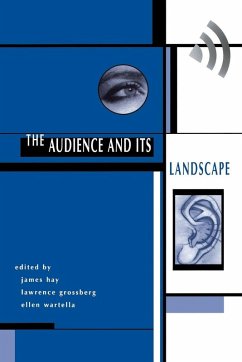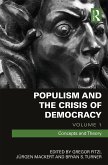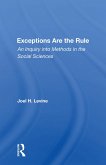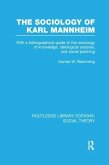James Hay
The Audience And Its Landscape
James Hay
The Audience And Its Landscape
- Broschiertes Buch
- Merkliste
- Auf die Merkliste
- Bewerten Bewerten
- Teilen
- Produkt teilen
- Produkterinnerung
- Produkterinnerung
This study offers a reassesment of the "audience". It acknowledges, in the face of conventional "discourse analysis", the contextual features of discourse, to produce complex and textured understanding of the concept of audience.
Andere Kunden interessierten sich auch für
![The Changing Institutional Landscape of Planning The Changing Institutional Landscape of Planning]() The Changing Institutional Landscape of Planning38,99 €
The Changing Institutional Landscape of Planning38,99 €![The Penal Landscape The Penal Landscape]() The Penal Landscape53,99 €
The Penal Landscape53,99 €![Populism and the Crisis of Democracy Populism and the Crisis of Democracy]() Populism and the Crisis of Democracy42,99 €
Populism and the Crisis of Democracy42,99 €![Exceptions Are The Rule Exceptions Are The Rule]() Joel LevineExceptions Are The Rule57,99 €
Joel LevineExceptions Are The Rule57,99 €![The Sociology of Karl Mannheim (RLE Social Theory) The Sociology of Karl Mannheim (RLE Social Theory)]() Gunter Werner RemmlingThe Sociology of Karl Mannheim (RLE Social Theory)59,99 €
Gunter Werner RemmlingThe Sociology of Karl Mannheim (RLE Social Theory)59,99 €![The Politics of Education The Politics of Education]() The Politics of Education69,99 €
The Politics of Education69,99 €![The New Narcissus in the Age of Reality Television The New Narcissus in the Age of Reality Television]() Megan CollinsThe New Narcissus in the Age of Reality Television55,99 €
Megan CollinsThe New Narcissus in the Age of Reality Television55,99 €-
-
-
This study offers a reassesment of the "audience". It acknowledges, in the face of conventional "discourse analysis", the contextual features of discourse, to produce complex and textured understanding of the concept of audience.
Produktdetails
- Produktdetails
- Verlag: Routledge
- Seitenzahl: 414
- Erscheinungstermin: 14. Juni 1996
- Englisch
- Abmessung: 229mm x 152mm x 22mm
- Gewicht: 597g
- ISBN-13: 9780813322858
- ISBN-10: 0813322855
- Artikelnr.: 21664583
- Herstellerkennzeichnung
- Libri GmbH
- Europaallee 1
- 36244 Bad Hersfeld
- gpsr@libri.de
- Verlag: Routledge
- Seitenzahl: 414
- Erscheinungstermin: 14. Juni 1996
- Englisch
- Abmessung: 229mm x 152mm x 22mm
- Gewicht: 597g
- ISBN-13: 9780813322858
- ISBN-10: 0813322855
- Artikelnr.: 21664583
- Herstellerkennzeichnung
- Libri GmbH
- Europaallee 1
- 36244 Bad Hersfeld
- gpsr@libri.de
James Hay was a prolific writer whose work primarily focused on mystery and detective fiction. His stories were known for their intricate plots and psychological depth, exploring the hidden motives and complexities of human behavior. Hay s narrative style combined suspense with detailed character development, making his works compelling to readers who appreciated both thrilling mysteries and thoughtful examinations of personality. In addition to his fiction writing, he was involved in journalism, where he addressed social issues and contributed to the literary culture of his time. His journalistic work reflected a similar insight into human nature and societal dynamics, which enriched his fictional storytelling. Throughout his career, Hay demonstrated a dedication to uncovering the layers of deception, secrets, and interpersonal relationships that drive human actions. His contributions helped shape early twentieth-century mystery literature and reporting techniques. While not widely known today, his influence is recognized among enthusiasts of classic detective fiction and historical literary studies. James Hay s legacy endures as a writer who blended entertainment with meaningful exploration of the human condition through both creative and factual writing.
Introduction
(James Hay, Lawrence Grossberg, and Ellen Wartella.)
Audience Studies And The Convergence Of Research Traditions
Viewers Work
(Elihu Katz.)
Combinations, Comparisons, and Confrontations: Toward a Comprehensive Theory of Audience Research
(Karl Erik Rosengren.)
Audience
Research: Antinomies, Intersection, and the Prospect of Comprehensive Theory
(David L. Swanson.)
After Convergence: Constituents of a Social Semiotics of Mass Media Reception
(Klaus Bruhn Jensen.)
The Pragmatics of Audience in Research and Theory
(James A. Anderson.)
Rethinking The Audience As An Object Of Study
Recasting the Audience in the New Television Marketplace?
(Jay G. Blumler.)
Toward a Qualitative Methodology of Audience Study: Using Ethnography to Study the Popular Culture Audience
(Andrea L. Press.)
Notes on Children as a Television Audience
(Ellen Seiter.)
Figuring Audiences and Readers
(Tony Bennett.
)
Marginal Texts, Marginal Audiences
(Larry Gross.)
Notes on the Struggle to Define Involvement in Television Viewing
(Tamar Liebes.)
On Not Finding Media Effects: Conceptual Problems in the Notion of an Active Audience (with a Reply to Elihu Katz)
(Robert Kubey.)
The Politics Of Audience Studies
The Politics of Producing Audiences
(Martin Allor.)
Power Viewing: A Glance at Pervasion in the Postmodern Perplex
(John Hartley.)
The Hegemony of Specificity and
the Impasse in Audience Research: Cultural Studies and the Problem of Ethnography
(Janice Radway.)
Ethnography and Radical Contextualism in Audience
Studies
(Ien Ang.)
Locating Audiences
Hemispheres of Scholarship:
Psychological and Other Approaches to Studying Media Audiences
(Byron Reeves.)
From Audiences to Consumers: The Household and the Consumption of Communication and Information Technologies
(Roger Silverstone.)
Audiencing Violence: Watching Homeless Men Watch
Die Hard
(John Fiske and Robert Dawson.)
The Geography of Television: Ethnography, Communications, and Commun
(James Hay, Lawrence Grossberg, and Ellen Wartella.)
Audience Studies And The Convergence Of Research Traditions
Viewers Work
(Elihu Katz.)
Combinations, Comparisons, and Confrontations: Toward a Comprehensive Theory of Audience Research
(Karl Erik Rosengren.)
Audience
Research: Antinomies, Intersection, and the Prospect of Comprehensive Theory
(David L. Swanson.)
After Convergence: Constituents of a Social Semiotics of Mass Media Reception
(Klaus Bruhn Jensen.)
The Pragmatics of Audience in Research and Theory
(James A. Anderson.)
Rethinking The Audience As An Object Of Study
Recasting the Audience in the New Television Marketplace?
(Jay G. Blumler.)
Toward a Qualitative Methodology of Audience Study: Using Ethnography to Study the Popular Culture Audience
(Andrea L. Press.)
Notes on Children as a Television Audience
(Ellen Seiter.)
Figuring Audiences and Readers
(Tony Bennett.
)
Marginal Texts, Marginal Audiences
(Larry Gross.)
Notes on the Struggle to Define Involvement in Television Viewing
(Tamar Liebes.)
On Not Finding Media Effects: Conceptual Problems in the Notion of an Active Audience (with a Reply to Elihu Katz)
(Robert Kubey.)
The Politics Of Audience Studies
The Politics of Producing Audiences
(Martin Allor.)
Power Viewing: A Glance at Pervasion in the Postmodern Perplex
(John Hartley.)
The Hegemony of Specificity and
the Impasse in Audience Research: Cultural Studies and the Problem of Ethnography
(Janice Radway.)
Ethnography and Radical Contextualism in Audience
Studies
(Ien Ang.)
Locating Audiences
Hemispheres of Scholarship:
Psychological and Other Approaches to Studying Media Audiences
(Byron Reeves.)
From Audiences to Consumers: The Household and the Consumption of Communication and Information Technologies
(Roger Silverstone.)
Audiencing Violence: Watching Homeless Men Watch
Die Hard
(John Fiske and Robert Dawson.)
The Geography of Television: Ethnography, Communications, and Commun
Introduction
(James Hay, Lawrence Grossberg, and Ellen Wartella.)
Audience Studies And The Convergence Of Research Traditions
Viewers Work
(Elihu Katz.)
Combinations, Comparisons, and Confrontations: Toward a Comprehensive Theory of Audience Research
(Karl Erik Rosengren.)
Audience
Research: Antinomies, Intersection, and the Prospect of Comprehensive Theory
(David L. Swanson.)
After Convergence: Constituents of a Social Semiotics of Mass Media Reception
(Klaus Bruhn Jensen.)
The Pragmatics of Audience in Research and Theory
(James A. Anderson.)
Rethinking The Audience As An Object Of Study
Recasting the Audience in the New Television Marketplace?
(Jay G. Blumler.)
Toward a Qualitative Methodology of Audience Study: Using Ethnography to Study the Popular Culture Audience
(Andrea L. Press.)
Notes on Children as a Television Audience
(Ellen Seiter.)
Figuring Audiences and Readers
(Tony Bennett.
)
Marginal Texts, Marginal Audiences
(Larry Gross.)
Notes on the Struggle to Define Involvement in Television Viewing
(Tamar Liebes.)
On Not Finding Media Effects: Conceptual Problems in the Notion of an Active Audience (with a Reply to Elihu Katz)
(Robert Kubey.)
The Politics Of Audience Studies
The Politics of Producing Audiences
(Martin Allor.)
Power Viewing: A Glance at Pervasion in the Postmodern Perplex
(John Hartley.)
The Hegemony of Specificity and
the Impasse in Audience Research: Cultural Studies and the Problem of Ethnography
(Janice Radway.)
Ethnography and Radical Contextualism in Audience
Studies
(Ien Ang.)
Locating Audiences
Hemispheres of Scholarship:
Psychological and Other Approaches to Studying Media Audiences
(Byron Reeves.)
From Audiences to Consumers: The Household and the Consumption of Communication and Information Technologies
(Roger Silverstone.)
Audiencing Violence: Watching Homeless Men Watch
Die Hard
(John Fiske and Robert Dawson.)
The Geography of Television: Ethnography, Communications, and Commun
(James Hay, Lawrence Grossberg, and Ellen Wartella.)
Audience Studies And The Convergence Of Research Traditions
Viewers Work
(Elihu Katz.)
Combinations, Comparisons, and Confrontations: Toward a Comprehensive Theory of Audience Research
(Karl Erik Rosengren.)
Audience
Research: Antinomies, Intersection, and the Prospect of Comprehensive Theory
(David L. Swanson.)
After Convergence: Constituents of a Social Semiotics of Mass Media Reception
(Klaus Bruhn Jensen.)
The Pragmatics of Audience in Research and Theory
(James A. Anderson.)
Rethinking The Audience As An Object Of Study
Recasting the Audience in the New Television Marketplace?
(Jay G. Blumler.)
Toward a Qualitative Methodology of Audience Study: Using Ethnography to Study the Popular Culture Audience
(Andrea L. Press.)
Notes on Children as a Television Audience
(Ellen Seiter.)
Figuring Audiences and Readers
(Tony Bennett.
)
Marginal Texts, Marginal Audiences
(Larry Gross.)
Notes on the Struggle to Define Involvement in Television Viewing
(Tamar Liebes.)
On Not Finding Media Effects: Conceptual Problems in the Notion of an Active Audience (with a Reply to Elihu Katz)
(Robert Kubey.)
The Politics Of Audience Studies
The Politics of Producing Audiences
(Martin Allor.)
Power Viewing: A Glance at Pervasion in the Postmodern Perplex
(John Hartley.)
The Hegemony of Specificity and
the Impasse in Audience Research: Cultural Studies and the Problem of Ethnography
(Janice Radway.)
Ethnography and Radical Contextualism in Audience
Studies
(Ien Ang.)
Locating Audiences
Hemispheres of Scholarship:
Psychological and Other Approaches to Studying Media Audiences
(Byron Reeves.)
From Audiences to Consumers: The Household and the Consumption of Communication and Information Technologies
(Roger Silverstone.)
Audiencing Violence: Watching Homeless Men Watch
Die Hard
(John Fiske and Robert Dawson.)
The Geography of Television: Ethnography, Communications, and Commun









